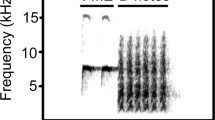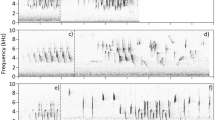Abstract
Complex acoustic signals in many animal species are characterized by a syntax that governs how different notes are combined, but the importance of syntax to the communicative function of signals is not well understood. Mated pairs of yellow-naped amazons, Amazona auropalliata, produce coordinated vocal duets that are used for territory maintenance and defense. These duets follow rules that specify the ordering of notes within duets, such as a strict alternation of sex-specific notes and a defined progression of note types through each duet. These syntactical rules may function to define sex-specific roles, improve coordination, and allow individuals to combine calls into meaningful sequences. As a first step toward understanding the functional significance of syntax, we conducted two separate audio playback experiments in which we presented nesting pairs with normal duets and duets with broken syntax (i.e., one of the syntactic rules was broken). In Experiment One, we reversed the order of female and male notes within note pairs while retaining the typical progression of note types through a duet. In Experiment Two we reversed the order of note types across a whole duet while retaining the typical female–male ordering within note pairs. We hypothesized that duets with broken syntax would be less-effective signals than duets with normal syntax and predicted that pairs would respond less to broken syntax than to normal duets. Contrary to predictions, we did not observe differences in response between treatments for any variables except latency to approach the speaker. After we combined data across experiments post hoc, we observed longer latencies to approach the speakers after playbacks of broken syntax duets, suggesting that pairs could differentiate between playbacks. These responses suggest that breaking one rule of duet syntax at a time does not result in detectable loss of signal efficacy in the context of territorial intrusions.



Similar content being viewed by others
References
Arnold K, Zuberbuhler K (2006) Semantic combinations in primate calls. Nature 441(18):303
Balaban E (1988) Bird song syntax: learned intraspecific variation is meaningful. Proc Natl Acad Sci USA 85:3657–3660
Ball GF, Hulse SH (1998) Birdsong. Am Psychol 53:37–58
Bradbury JW, Vehrencamp SL (1998) Principles of animal communication. Sinauer Associates, Sunderland
Cabin RJ, Mitchell RJ (2000) To Bonferroni or not to Bonferronni: when and how are the questions. Bull Ecol Soc Am 81(3):246–248
Catchpole CK, Slater PJB (2008) Bird song: biological themes and variations, 2nd edn. Cambridge University Press, Cambridge
Charrier I, Sturdy CB (2005) Call-based species recognition in black-capped chickadees. Behav Process 70:271–281
Clarke E, Reichard UH, Zuberbühler K (2006) The syntax and meaning of wild gibbon songs. PLoS ONE 1:e73
Clucas B, Freeberg TM, Lucas JR (2004) Chick-a-dee call syntax, social context, and season affect vocal responses of Carolina chickadees (Poecile carolinensis). Behav Ecol Sociobiol 57:187–196
Collins S (2004) Vocal fighting and flirting: the functions of birdsong. In: Marler P, Slabbekoorn H (eds) Nature’s music: the science of birdsong. Elsevier Academic Press, Amsterdam, pp 39–78
Dahlin CR (2010) Structure and function of a complex vocal signal: duets of the yellow-naped amazon, Amazona auropalliata. Dissertation, New Mexico State University, Las Cruces
Dahlin CR, Wright TF (2009) Duets in yellow-naped amazons: variation in syntax, note composition and phonology at different levels of social organization. Ethology 115:857–871
Dahlin CR, Wright TF (2012) Duet function in the yellow-naped amazon, Amazona auropalliata: evidence from playbacks of duets and solos. Ethology 118:95–105
Esser K, Condon CJ, Suga N, Kanwal JS (1997) Syntax processing by auditory cortical neurons in the FM-FM area of the mustached bat, Pteronotus parnelli. Proc Nat Acad Sci 94:14019–14024
Farabaugh SM (1982) The ecological and social significance of duetting. In: Kroodsma DE, Miller EH (eds) Acoustic communication in birds, vol 2. Academic Press, New York, pp 85–124
Freeberg TM, Lucas JR (2002) Receivers respond differently to chick-a-dee calls varying in note composition in Carolina chickadees, Poecile carolinensis. Anim Behav 63:837–845
Freeberg TM, Lucas JR, Clucas B (2003) Variation in chick-a-dee calls of a Carolina chickadee population, Poecile carolinensis: identity and redundancy within note types. J Acoust Soc Am 113:2127–2136
Garamszegi LZ (2006) Comparing effect sizes across variables: generalization without the need for Bonferroni correction. Behav Ecol 17:683–687
Hailman JP, Ficken MS (1987) Combinatorial animal communication with computable syntax: chick-a-dee calling qualifies as ‘language’ by structural linguistics. Anim Behav 34:1899–1901
Hall ML (2004) A review of hypotheses for the functions of avian duetting. Behav Ecol Sociobiol 55:415–430
Hall ML (2009) A review of vocal duetting in birds. Adv Stud Behav 40:67–121
Hauser MD, Chomsky N, Fitch T (2005) The faculty of language: what is it, who has it, and how did it evolve? Science 298:1569–1579
Holland J, Dabelsteen T, Paris AL (2000) Coding in the song of the wren: importance of rhythmicity, syntax and element structure. Anim Behav 60:463–470
Jackendoff R (1999) Possible stages in the evolution of the language capacity. Trends Cogn Sci 3(7):272–279
Kroodsma DE (1989) Suggested experimental designs for song playbacks. Anim Behav 37:600–609
Lachlan RF, Verhagen L, Peters S, Cate CT (2010) Are there species-universal categories in bird song phonology and syntax? A comparative study of chaffinches (Fringilla coelebs), zebra finches (Taenopygia guttata), and swamp sparrows (Melospiza georgiana). J. J Comp Psychol 124(1):92–108
Levin RN (1996) Song behaviour and reproductive strategies in a duetting wren, Thryothorus nigricapillus: I. Removal experiments. Anim Behav 52:1093–1106
Logue DM (2006) The duet code of the female black-bellied wren. Condor 108:326–335
Logue DM (2007) How do they duet? Sexually dimorphic behavioural mechanisms structure duet songs in the black-bellied wren. Anim Behav 73:105–113
Logue DM, Chalmers C, Gowlans H (2008) The behavioural mechanisms underlying temporal coordination in black-bellied wren duets. Anim Behav 75:1803–1808
Lowe SS, Nekolaichuk CL, Fainsinger RL, Lawlor PG (2008) Should the rate of opioid dose escalation be included as a feature in a cancer pain classification system? J Pain Symptom Manag 35:51–57
Mann NI, Marshall-Ball L, Slater PJB (2003) The complex song duet of the plain wren. Condor 105:672–682
Marler P (1997) Three models of song learning: evidence from behavior. J Neurobiol 33:501–516
Marler P (2004) Science and birdsong: the good old days. In: Marler P, Slabbekoorn H (eds) Nature’s music, vol 1. Elsevier Academic Press, Amsterdam
Marler P, Peters S (1977) Selective vocal learning in a sparrow. Science 198:519–521
Marler P, Peters S (1989) Species differences in auditory responsiveness in early vocal learning. In: Dooling RJ, Hulse S (eds) The comparative psychology of audition: perceiving complex sounds. Lawrence Erlbaum, Hillsdale, pp 243–273
Marler P, Pickert R (1984) Species-universal microstructure in the learned song of the swamp sparrow, Melospiza georgiana. Anim Behav 32:673–689
Marler P, Sherman V (1983) Song structure without auditory feedback: emanations of the auditory template hypothesis. J Neurosci 3:517–531
Marler P, Sherman V (1985) Innate differences in singing behavior of sparrows reared in isolation from adult conspecific song. Anim Behav 33:57–71
Marshall-Ball L, Slater JB (2004) Duet singing and repertoire use in threat signalling of individuals and pairs. Proc R Soc Lond B 271:S440–S443
Nakagawa S (2004) A farewell to Bonferroni: the problems of low statistical power and publication bias. Behav Ecol 15:1044–1045
Nottebohm F (1972) The origins of vocal learning. Am Nat 106:116–140
Nowak MA, Komarova NL, Niyogi P (2001) Evolution of universal grammar. Science 291:114–118
Nowak MA, Komarova NL, Niyogi P (2002) Computational and evolutionary aspects of language. Nature 417:611–617
Nowicki S, Searcy WA, Hughes M, Podos J (2001) The evolution of bird song: male and female response to song innovation in swamp sparrows. Anim Behav 62:1189–1195
Peters S, Searcy WA, Marler P (1980) Species song discrimination in choice experiments with territorial male swamp and song sparrows. Anim Behav 28:393–404
Podos J, Nowicki S, Peters S (1999) Permissiveness in the learning and development of song syntax in swamp sparrows. Anim Behav 58:93–103
Podos J, Huber SK, Taft B (2004) Bird song: the interface of evolution and mechanism. Annu Rev Ecol Evol Syst 35:55–87
Slabbekoorn H, Smith TB (2002) Bird song, ecology and speciation. Phil Trans R Soc Lond B 357:493–503
Slater PJB (1986) The cultural transmission of bird song. Trends Ecol Evol 1(4):94–97
Slater PJB (1997) Singing in the rain forest: the duets of bay wrens. Trends Ecol Evol 12:207–208
Smith WJ (1988) Patterned daytime singing of the eastern wood peewee Contopus virens. Anim Behav 36(4):1111–1123
Smith WJ (1991) Singing is based on two markedly different kinds of signaling. J Theor Biol 152:241–254
Templeton AR, Greene E, Davis K (2005) Allometry of alarm calls: black-capped chickadees encode information about predator size. Science 308:1934–1937
Valderrama S, Parra J, Davila N, Mennill DJ (2008) Vocal behavior of the critically endangered Niceforo’s wren (Thryothorus nicefori). Auk 125:395–401
Vehrencamp SL, Ritter AF, Keever M, Bradbury JW (2003) Responses to playback of local vs distant contact calls in the orange-fronted conure, Aratinga canicularis. Ethology 109:37–54
Vencl F, Souček B (1976) Structure and control of duet singing in the white-throated laughing thrush, (Garrulax leucolophus). Behaviour 57:206–225
Wright TF (1996) Regional dialects in the contact call of a parrot. Proc R Soc Lond [Biol] 263:867–872
Wright TF (1997) Vocal communication in the yellow-naped amazon (Amazona auropalliata). Ph.D. dissertation, University of California, San Diego, La Jolla
Wright TF, Dahlin CR (2007) Pair duets in the yellow-naped amazon (Amazona auropalliata): phonology and syntax. Behaviour 144:207–228
Wright TF, Dorin M (2001) Pair duets in the yellow-naped amazon (Psittaciformes: Amazona auropalliata): response to playbacks of different dialects. Ethology 107:111–124
Wright TF, Dahlin CR, Salinas-Melgoza A (2008) Stability and change in vocal dialects of the yellow-naped amazon. Anim Behav 76:1017–1027
Zar JH (1999) Biostatistical analysis, 4th edn. Prentice-Hall, Upper Saddle River
Zuberbuhler K (2002) A syntactic rule in forest monkey communication. Anim Behav 63:293–299
Acknowledgments
We thank the Area de Conservacíon Guanacaste (in particular Roger Blanco) and landowners in Costa Rica (in particular Fernando Pinto) for permitting and facilitating our fieldwork. We thank Laura Riba Hernandez for her assistance in locating parrots and conducting the experiment. Special thanks go to Kathryn Hanley and Thomas Schuster for comments and technical assistance. Funding for equipment, field-work and manuscript preparation came from the United States Environmental Protection Agency under the Greater Research Opportunities Graduate Program grant MA-91670701-0 (CRD), National Institutes of Health grant S06 GM008136 (TFW), National Science Foundation grant IOS-0725032 (TFW), the Department of Biology at New Mexico State University, the World Parrot Trust, the Chapman Award through the Museum of Natural History, Zeiss Optics, the Associated Students of New Mexico State University, and the Willoughby Nason Fellowship and the Watts Merit Fellowship through New Mexico State University.
Author information
Authors and Affiliations
Corresponding author
Rights and permissions
About this article
Cite this article
Dahlin, C.R., Wright, T.F. Does syntax contribute to the function of duets in a parrot, Amazona auropalliata?. Anim Cogn 15, 647–656 (2012). https://doi.org/10.1007/s10071-012-0493-y
Received:
Revised:
Accepted:
Published:
Issue Date:
DOI: https://doi.org/10.1007/s10071-012-0493-y




